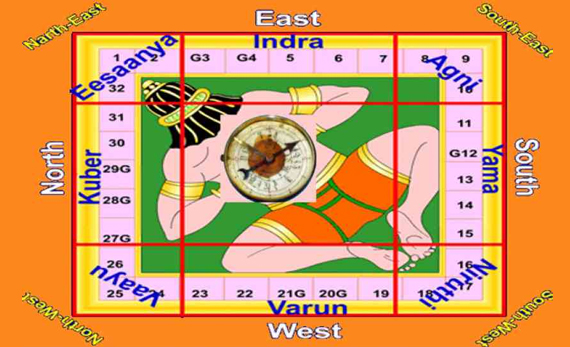The Sanskrit word vastu means a dwelling or house with a corresponding plot of land.] The vrddhi, vāstu, takes the meaning of "the site or foundation of a house, site, ground, building or dwelling-place, habitation, homestead, house". The underlying root is vas "to dwell, live, stay, abide". The term Shasta may loosely be translated as "science, doctrine, teaching". Besides, some say that Vastu was one of the greatest architect and town planning expert ever produced by India who lived 2000 years ago. The king would send him for planning and establishing a town. This concept of Vastu is not highlighted anywhere.There are many principles in Vaastu Shastra. To mention a few which involve certain mathematical calculations, Maana is used for proportional relationships in a building and Aayaadi specifies conditions for maximum well being and benefits for the residents of a building. Below are some of the basic theories in vaastu sastra.

Five elementstAccording to vastu sastra, the world comprises five basic elements known as the pancha maha bhoota. Out of the eight planets, ours has life because of the presence and balance of these five elements. The five elements are as follows.
EARTH (Bhumi) - Earth, the third planet in order from the sun, is a big magnet with North and South poles as centers of attractions. Its magnetic field and gravitational force has considerable effects on everything on the Earth, living and non-living
WATER (Jal) - This is represented by rain, river, sea and is in the form of liquid, solid (ice) and gas (steam, cloud). It forms part of every plant and animal. Our blood is mostly water.
AIR (Vayu) - As a life supporting element, air is a very powerful life source. Human physical comfort values are directly and sensitively dependent on correct humidity, air flow, temperature of air, air pressure, air composition and its content.
FIRE (Agni) - Represents light and heat which account for day, night, the seasons, energy, enthusiasm, passion and vigour.
SPACE (Akasha) - The Akasha provides shelter to all the above elements. It is also considered the primary conductor of all energy sources within the universal context – physical energies such as sound and light, social energies such as psychological and emotional, and cognitive energies such as intellect and intuition.
There is an invisible and constant relation between all the five elements. Thus, the person can improve their conditions by properly designing their buildings by understanding the effectiveness of these five natural forces. Vaastu Sastra combines all the five elements of nature and balances them with the person and the material. It takes advantage of the benefits bestowed by the five elements of nature to create a congenial living and working environment thereby facilitating spiritual well-being and paving the way for enhanced health, wealth, prosperity and happiness. In Indian architecture, the dwelling is itself a shrine. A home is called Manushyalaya, literally, "Human Temple". It is not merely a shelter for human beings in which to rest and eat. The concept behind house design is the same as for temple design, so sacred and spiritual are the two spaces. The "open courtyard" system of house design was the national pattern in India before Western models were introduced. The order introduced into the "built space" accounts for the creation of spiritual ambiance required for the indweller to enjoy spiritual well-being and material welfare and prosperity. At right is a typical layout of a square building, with a grid of 9x9=81 squares, meant for family persons (for scientists, artists and yogi a grid of 8x8=64 is prescribed). The space occupied by the central 3x3=9 squares is called Brahmasthanam, meaning the "nuclear energy field". It should be kept unbuilt and open to the sky so as to have contact with the outer space (akasha). This central courtyard is likened to the lungs of the human body. It is not for living purposes. Religious and cultural events can be held here—such as yajna (fire rituals), music and dance performances and marriage. The row of squares surrounding the Brahmasthanam is the walkway. The corner spaces, occupying 2x2=4 squares, are rooms with specific purposes. The northeast quarter is called Isanya, the southeast Agni, the southwest Niruthi and northwestVayu. These are said to possess the qualities of four respective devatas or gods—Isa, Agni, Niruthi and Vayu. Accordingly—with due respect to ecological friendliness with the subtle forces of the spirit—those spaces (quarters) are assigned as follows: northeast for the home shrine, southeast for the kitchen, southwest for the master bedroom and northwest for the storage of grains. The spaces lying between the corner zones, measuring 4x6=24 squares (6 on each side), are those of the north, east, south and west. They are meant for multi purposes.
© Copyright 2019 by DivineinSoul. All right Reserved | Designed & Developed by Hi-Techsoft Services.